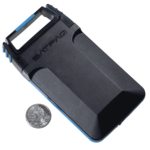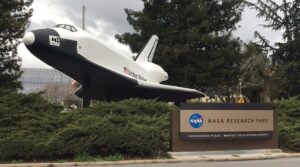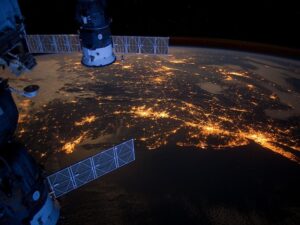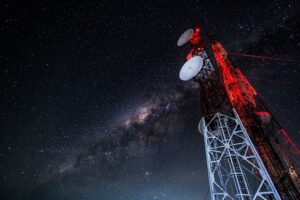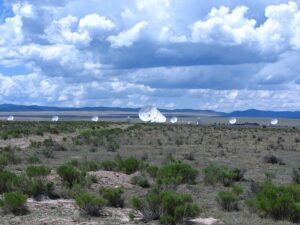We’ve all been a little weirded out by the recent news of odd stuff flying in the sky getting shot down. What the heck is going on up there? And who knows what else is in the sky?
I don’t know. But Rob Reis does. He’s the CEO and founder of Higher Ground and the inventor of SatPaq, which is one of those compact devices that you always wish you had on you while you’re walking in the woods and can’t get any signal on your cell phone. It’s a very compact device that enables a smartphone to send and receive messages over a geostationary satellite, they’re known as GEO satellites and they’re 23,000 miles above earth.
Higher Ground is expanding this technology initially created for consumers, with NASA now and the Department of Homeland Security.
I was reading a LinkedIn post by my gal pal, Lois Whitman, who is very close to Rob and she was writing about his knowledge of what goes on above us in the sky every day. More important, his knowledge of maybe why these latest sky balloons in the news, these shapes, these sizes were up there and what they were doing. I found that that very interesting and I find Rob very interesting, so I invited him to be my guest on this show.
First about SatPaq, I wondered how Rob got that idea. I asked him, “Are you a technology guy?” “Are you a guy who got lost in the woods with no cell?” LOL . Both he said. Rob who lives in Silicon Valley has done four startup companies. An inventor at heart he also does a fair amount of hiking and backpacking. And he reiterated that, anytime you go hiking, fishing, just exploring, you’re commonly out of cell phone coverage. Ten years ago, he started working on the SatPaq because people just want to have connectivity wherever they are.
Tell me about it. I can’t count how many times I’ve been walking behind my crazy old hippie boyfriend in the woods thinking, no one’s going to find us if something happens. I bring it up every time and he always says I’m neurotic. Nope. I just want to stay alive and not not be found if I need to be found! It’s very disconcerting to not be connected considering how much we rely on being connected every day. Even when I sometimes go to a certain area of people’s neighborhoods that are more rural, where I have friends or I do business, and have no cell service I can’t take it. So, I know Rob’s SatPaq is something that the world welcomed.
But Rob pointed out that the consumer market was not as interested in this as the NASA folks and the Homeland Security folks were, so he’s doing a lot of business with them now.
Rob said, “We introduced the SatPaq into the consumer market about four years ago and we had some reasonable response. I would say we have a couple of thousand SatPaqs in consumer hands. But it really was the special forces who found us about three years ago and basically said, we need that kind of capability. What we’re providing is really a pocket-sized device for the soldier that he/she can operate anywhere. And what makes it special is that it’s so stealthy. So that’s different than a consumer need, and the military needs it so nobody can intercept the signal.”
I asked Rob who spends a lot of time in his head 23,000 feet in the air, to speak to all these crazy balloons in the sky that were just shot down. Was he shocked, surprised, not surprised? “Not that surprised”, he said. “I used to be involved in the intelligence industry 25, 30 years ago. We’ve got a lot of different assets up there at different altitudes. There’s Leo satellites, which are low earth orbit and the Geos, are about 23,000 miles, so they’re 50 times further and we have airplanes. I was a little surprised by a balloon, but a balloon basically makes sense in terms of some kind of interception gear.” Frankly he said, you can put a much larger antenna on a balloon. “A typical satellite is like a meter across the ones that go up at 500 miles above the earth. And you really want to have a much bigger antenna. If you need a big antenna, you can’t put it on a small satellite and a balloon makes a lot more sense.”
Rob said there are probably 50,000 satellites in the sky right now. Imagine?
Are they color coded I asked? How does everybody know who satellite is whose?
“Well, the good news said Rob, is that space really is big and in general, there’s good focus on where every company positions their satellite to make sure it’s not going to interfere with some other satellite, both physically and radio wise. So, there’s good control. But it’s changing. There are concerns about, you know, space debris. Sometimes when satellites fall apart or they reenter the atmosphere, or sometimes when other governments destroy them, you end up with all these little particles that don’t come down. The issue of space debris is becoming of concern, and it should be. So right now, we’re okay, but the future we must be more careful. “
While talking to Rob I was trying to wrap my mortal head around what’s going on up in the sky on any given day. On any given day here are like 7,000 planes and 60,000 satellites in the sky and now we know we have these giant balloons flying around. How high are these giant balloons able to fly I wondered?
Rob said, the one that was brought down was at 60,000 feet and most commercial aircraft fly between 15,000 and 35,000 feet. So, it was above the flight paths of typical commercial airplanes, but he added, it’s a space that typically only military equipment go to 60,000 feet which is quite a way up.
In terms of kind of going from ground up, the commercial aircrafts are at about 30,000 to 35,000 feet, which is five, six miles. That big balloon that was brought down was at 60,000 feet which is about 12 miles up. Satellites start at 100 miles up.
In following the bouncing balloon here, I was wondering why such a big balloon was in the sky that far up? And what was it supposed to provide? Obviously some intelligence that somebody couldn’t get by looking at a Google Earth map.
“The first question maybe a couple of weeks ago was, you know, what kind of intelligence are they likely to be getting? And you first start thinking about photo intelligence pictures because pictures do tell you a lot about what’s happening below. And maybe 30, 40 years ago, getting photos from space with something that only governments could do. But in the last maybe 15 years, a whole bunch of companies. have put up their own small satellites with cameras. And people are now comfortably going to Google Earth and really, you’re getting pictures from commercial satellites.”
So, the real question is, if you can get the photos from the internet, why put up a balloon? “Right”, said Rob. “What you see on Google Earth and others is impressive in terms of resolution. It has been confirmed, because people have picked up or the military government has picked up the remains of what was found in the waters off South Carolina, and they’ve shown that what it really was is an antenna.”
“You know, we’re not talking photo information. We’re talking signal intelligence. So that means you’re not really looking at a picture of what’s on the ground. You want to see what kind of radios are being used because that also tells you a lot about what happens below. And to get radio signals, it really comes down to something called aperture, which is how big is the array and the larger the array, the more sensitive it can be, and the better you can figure out where the signals are coming from. When they started showing photos and you saw a 200 put balloon and you saw a big girder structure, which appears to be maybe 150 feet. Something that big must be picking up signal information. And that’s the hypothesis now confirmed that it’s an antenna. “
I read is that a helium balloon 200 feet in diameter can lift 250,000 pounds. That would be the equivalent to carrying 60 cars in the sky? “Yes”, said Rob. “It just shows that when you have a really big balloon, you can carry a whole bunch at 200 feet. It’s like two thirds of a football field so these are enormous balloons. But when you look at the photos, you’re not seeing that big of a structure below. So, this was not about weight. This was about kind of girth or width. And when you start thinking about what needs width, that’s really an antenna array. I’m going to guess that what’s being carried below is 5,000 pounds,10,000 pounds When you look at the photos of the 200-foot balloon, you see these big guy wires. And it’s meant to keep the antenna array relatively stable. It all makes sense when you see the photo and you understand kind of the physics behind it.”
I did ask Rob my signature Debbie question, “What goes on in your head all day long?”
“I do startups. What we’re building with the SatPaq is on the other side of this equation, which is if you’re building something for the military, how do you make sure that the adversary can’t pick it up? So, we’re now talking about a balloon and what they’re trying to pick up. And we’re thinking what do we do to make sure that our military has very, very stealthy equipment. In the professional world, that’s what I’m spending my time thinking about. We’ve come up with a bunch of clever things. And obviously I can’t talk about how we’re doing it, but that’s what the SatPaq does is provide virtually undetectable communications from the ground for our military. And frankly, as an engineer, it’s really fun to be building something that special, which is that important to our troops.”
What an amazing way for a man to be spending his day for the good of us all. Enjoy this fascinating podcast conversation with Rob Reis, CEO and Founder of Higher Ground and inventor of the SatPaq from our live conversation The Debbie Nigro Show.
The world has to be grateful for brains like that of Rob Reis.


